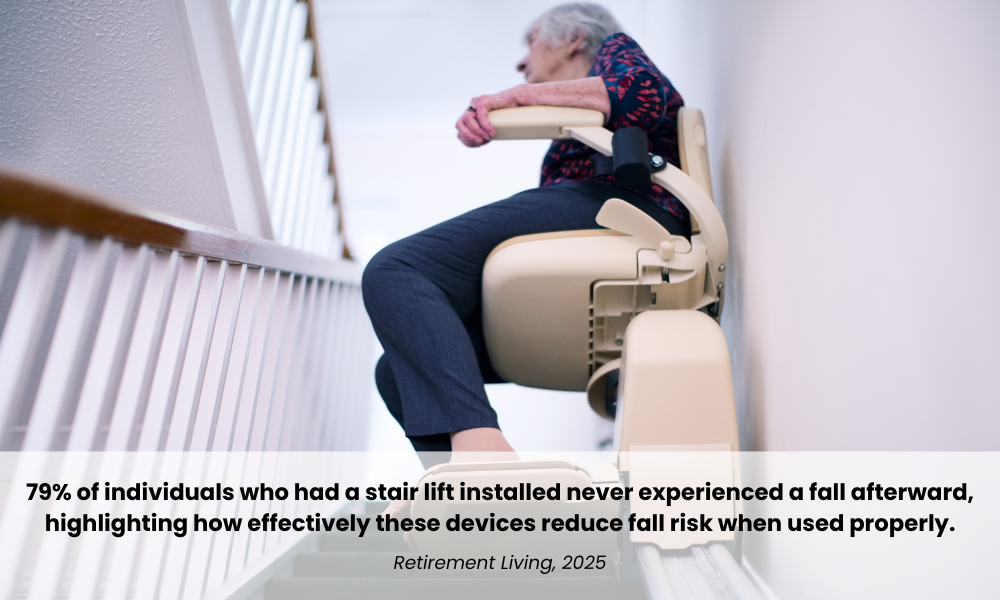
How to Safely Use a Stair Lift When You Have Pets at Home
September 10, 2025Stair lifts are an important mobility resource for seniors and people with disabilities to enable them to move safely and independently between floors of their home. With pets in the home, it’s important to make considerations for their safety as well. Dogs and cats are naturally curious, which can create potential safety hazards when using moving equipment like stair lifts. That’s why stair lift safety for pets should always be part of your mobility planning.
This article will address how to make the stair lift use for pets to ensure the protection for both your loved ones, and your pets.

Why Pets and Stair Lifts Can Be a Risky Mix
Dogs are loyal. Cats are curious. Both have a tendency to follow the actions of their human companions. A stair lift in motion is a moving object that many pets can either try to chase or ride on. These situations highlight the importance of stair lift safety for pets since even small accidents can put both your pet and your equipment at risk.
These actions can be dangerous, and pets can:
- Get tangled in moving parts or underneath the footrest
- Trip sensor mechanisms, stopping the lift from functioning
- Climb onto the seat and cause damage as the stair lift moves
- Shed fur that can get stuck on the track and decrease performance
In multi-pet environments, the American Humane Association has recently underscored that the issue of home equipment accident rates are on the rise. For this reason, stair lift safety for pets should form part of your safety planning and not as an afterthought.
Designing a Pet-Safe Stair Lift Setup from Day One
Smart planning starts from the installation stage. Leading companies like EZ Living Concepts install stair lifts with small profile designs such as Handicare 1000 and Pinnacle SL600 stair lifts developed for optimum space containment.
By choosing designs with folding arms and seats, tightly fastened rails, auto-stop sensors, and footplate safety edges, you’re already building a foundation for stair lift safety for pets.You can also consider installing gate systems to ensure the base of stairs the pets cannot access when the stair lift is in use. These minor changes can have a large impact on stair lift safety for pets right from the start.

Stair Lift Safety for Pets: Training, Tools & Daily Habits
Some stairs lifts are pet/good for pets only if you help make it that way. Creating an intentional routine ensures stair lift safety for pets becomes part of daily life.
Below are some real-world strategies to keep pets and people safe:
- Train with Purpose
Use commands and gentle corrections when your pet approaches the lift. Treats and consistency are key. If your dog understands the command “stay,” practice using “stay” at the stairs while the lift is in operation. For cats, you might use a citrus spray or foil barrier to deter them from sitting on the track. - Establish Boundaries
Install barrier gates for babies or temporary pet barriers around the stairwell. Particularly during early adjustment weeks, boundaries are one of the most effective ways to guarantee stair lift safety for pets. - Consider Supervision at First
For the first few weeks of stair lift installation, supervise all stair lift trips. Observe your pet’s behavior. For example, if your cat tends to sit at the base of the stairs, this is a warning sign. Rearrange your space, train around it, and eliminate any possible rest stops around the track. - Make It Routine
Animals follow a routine. For example, if they have been given food or an opportunity to go outside before using the stair lift, they are less likely to intervene in your plans. These types of routines can be easily incorporated into your daily schedule. - Reward Good Behavior
Make sure you, and your pet, reinforce calm behavior. Bribes (treats, praise, or time playing somewhere other than on the stairs) reinforce those imaginary boundaries.
When you add new habits and routines, stair lift safety for pets becomes second nature.
What If My Pet Tries to Ride the Lift
This happens more than most people believe it will. Cats and some smaller dogs are curious by nature. Eventually, they may jump onto the stair lift seat. Luckily, with the technological advances of home stair lifts, all of them have safety features to help us out. For example, weight sensors, which allow the stair lift to run only when someone is seated in the seat. There are emergency stop buttons and manual overrides for many reasons, but if something unpredictable happens, they can offer an extra safety net.
These technological advances were designed not just for people, but also to ensure stair lift safety for pets in homes where animals are part of the family.
Maintenance: More Important Than You Think
Pet hair is one of the most commonly thought of, and commonly neglected, mechanical problems as it relates to home stair lift usage. It can build up in the track, moving parts, leading to increased friction, reduced efficiency, and eventually, mechanical failure. Cleaning regularly is critical in order to maintain performance and assure safety.
According to Johns Hopkins-led data, an estimated 422,659 adults were treated in U.S. emergency departments for injuries related to leash-dependent dog walking between 2001 and 2020, with traumatic brain injuries and finger fractures among the most common outcomes
To stay ahead of issues:
- Vacuum the stair lift track once per week
- Use a pet-safe disinfectant to clean the seat and footplate
- Have a professional service the stair lift every 6-12 months
A clean stair lift is not just more pleasant—it directly contributes to stair lift safety for pets and smoother operation for riders.